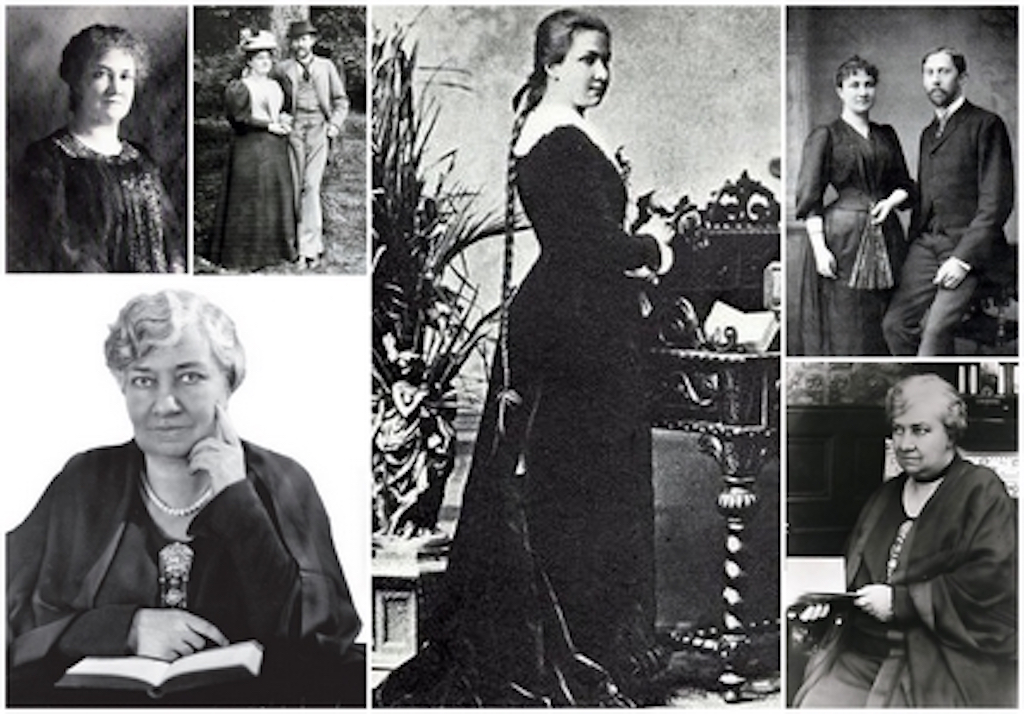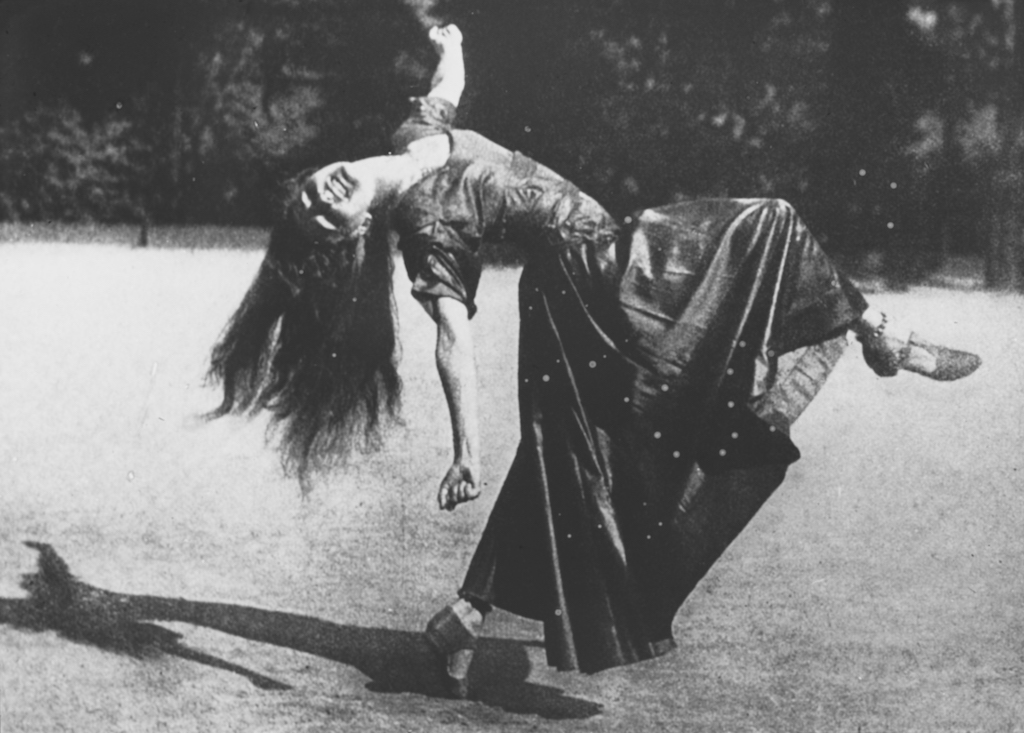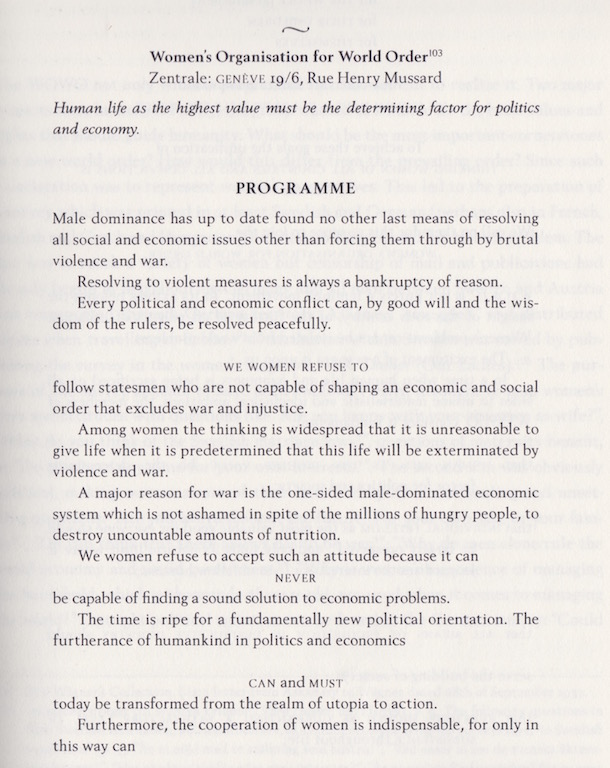E L I N W Ä G N E R ´ S S E C O N D P L A T F O R M - W O W O
Introduction summary
After the discovery of the fascinating and encouriging research in the field of Modern Matriarchal Science with its center in southern Germany in The International Academy of HAGIA, directed by the eminent scholar dr Heide Göttner-Abendroth, which is totally omitted from the Swedish feminist discussion, it was also a big surprise to discover its close connection to our own Swedish ecofeminist tradition through Elin Wägner´s affinity with the ecofeminist movement in the same German/Austrian area; WOWO, investigated by Katarina Leppänen in her dissertation: Rethinking Civilisation in a European Feminist Context, History, Nature Women in Elin Wägner´s Väckarklocka.
In fact; the World Congresses on Societies in Balance and of Peace directed by Heide Göttner -Abendroth, with the back up companionship by the director of the Institute of Gift Economy: Genevieve Vaughan of the last one, are it´s contemporary equivalents, pursuing almost exactly the same kind of agenda, as the same problems as by then some 80 years ago still remain today, or has even got worse.
Because of its quite radical aim to create a complete new word-order built on matriarchal principles, it was regarded as a threat to male stream society and banned by the national democrats emerging in the 30s Germany in Austria, why its promotors had to keep their documents secret and even burn them when the nazi oppression increased, which is one of the reasons to why its history hitherto has remained in shadow.
Of this reason, as well as many others, it is of total irrelevance to insinuate that interest in prehistoric matriarchy would have fascist and/or nazist undertones. Quite the contrary this kind of ecofeminism, encouraged and inspired by the study of matriarchal societies, is as far away from fascist / nazist ideology you can get, which I hope will come clear in my writings on this Website/blog as well as this short review of the ideology of WOWO, with some of my own reflections in addition to Leppänens texts and others. The cornerstone of fascist /nazist ideology is male dominance enforced by violence, thus it is the complete opposite to the fundamental basics of balance and peace in matriarchy (according to the definition of Heide Göttner-Abendroth. And I guess that´s the reason why there were few publicists in this country who were more distinctly well articulated in their critique against fascist & nazist ideology and dictatorship (as well as the one of Stalin in Sovjet) than Elin Wägner, during this period in the first half of the 20th century.
Writing this page about WOWO has evoked much curiosity and fascination about this period of high culture in Vienna, with its splended glory starkly outstanding to the primitive misogyny, dwelling close to the sparkling surface. From this culture historian retrospektion you get a more distinct perception of what has changed since then or not. What strucks you most is the amazing stupidity wrapped into layers of pompous abracadabra in order to appear as "science" and to what great extent much of this incredible stupidity still is referred to as serious "science", whilst the findings and reasoning of those who came up with really clever things although they didn´t have access to higher education still are referred to as "popular science" or dismissed as "nonscientifical" or "amateur"- "popular-science" etc etc, if they are mentioned at all.
Of course, it could on one hand be considered as a progress, its no longer being sanctioned as "science" to come up with a lot of stupid nonsense about the "nature" of the female and her sexual preferences of the kind of Weininger´s et al.. But on the other; why then isn´t this kind of nonsense omitted from the schoolbooks and /or encyclopaedias and / or delineated as "popular science" and / or as unproved "non-scientifical", as that is what has been done to so many of the scholars who credibly have presented a lot of significant findings of past as well as present "matriarchal societies" according to the definition elaborated by Dr Heide Göttner-Abendroth.
Just tell when the proverb; Strait at a gnat and swallow a camel has been more adequate!
I would highly recommend you all, to take a look at this text by Otto Weininger: Sex and Character (Geschlect und Charakter) 1903 in order to get a relevant view of what kind of lunatic nonsense that has put its hallmark on the view of the "female nature" and to an alarmingly great deal has been prevalent up until today in many layers of our modern western civilisation.
If you undertake a little private investigation in order to find out in what way Weininger is presented and commented in cyberspace, you will soon notice that he mostly is criticised for his stupid nonsense about the "jewish", but not much is said about his harsh misogyny.
At least the German-speaking feminists haven´t spent their time lying on their backs letting this male stream oratorio ululate its disastrous message unchallenged.
Firstly there was Rosa Mayreder in the beginning of the 20th century answering the question: What is a woman? with her Sex and culture (Geschlecht und Kultur) 1932 in which she convincingly move the focus from nature to culture, and secondly there is nowadays the World Congress lecturer Claudia von Werlhof with her article; Geschlecht und Gewalt (Sex and violence) which further the dialogue with focus on the violence and warfare needed to hold on to status quo and nowadays threatens to destroy the future of humankind.
As so many important questions have turned up during the inquiry of the Vienna context I have perhaps bulged into far too many paranthesises and references, and would therefore like to use Elin Wägner´s own words quoted below;
"My aim with the following is not to replace the study of the work mentioned above but to encourage to that. The material is far away from complete yet. But we will have to take the risk and draw our conclusions although. We cannot sit pasted on to the old history writing, it is much too dangerous if we so do."
≈
As Elin Wägner in the year of 1936 experienced some tribulations in her networking with her Fogelstad group and were very much concerned about the situation in Europe, she writes in her "Work book" that "she suffers from, bad sleep, anxiety, periodically reduced work capacity, nervousness, a feeling of alienation in her time, feeling of guilt and frustration. The silence from God and his absence."
But then all of a sudden, this heavy winter, there was a cheerful and encouraging voice calling, loaded with hopeful future. It came from WOWO through a letter from its founder Anna Helene Askanasy - AHA.

Askanasy portrayed by Flory Gate, who also visited the WOWO congresses
Anna Helene Askanasy (fl.1930-1970) a Viennese women, and Gustav Mahler's niece, had been involved in both women's movement and the movement for peace which sprang up in Austria in the wake of the First World War. She spoke at the conference on statelessness which was organised by Mary Sheepshanks at the request of the Women's International League for Peace and Freedom and which was held in Sep 1930. She was deeply passionate about women's history and also entered into correspondence with Robert Briffault author of the giant three binding The Mothers and offered him to stay in her summer house when he was in financial problems, in order to write one of his books.
A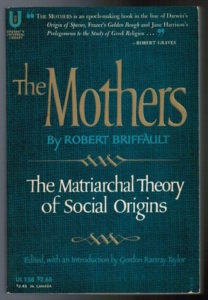 t another stage she began writing a book in German whose English translation was The Catastrophe of Patriarchy and worked with Birgitta M Schulte on the publication of the Encyclopaedia der Frau in Switzerland in 1953-1954. Askanasy was an amateur women's historian herself and published a historical novel Empress of Byzantium (1952) under the pseudonym Helen A. Mahler. Her unpublished book, The Catastrophe of Patriarchy, also reflects her interest in the subject. After the Nazis taking over Austria 1938, her husband was killed and she emigrated to Canada in 1938, where she planned to start ecological farming on a cooperative basis together with her friends. (Elin Wägner was for a while pondering this alternative) She appears to have been active until around 1970.
t another stage she began writing a book in German whose English translation was The Catastrophe of Patriarchy and worked with Birgitta M Schulte on the publication of the Encyclopaedia der Frau in Switzerland in 1953-1954. Askanasy was an amateur women's historian herself and published a historical novel Empress of Byzantium (1952) under the pseudonym Helen A. Mahler. Her unpublished book, The Catastrophe of Patriarchy, also reflects her interest in the subject. After the Nazis taking over Austria 1938, her husband was killed and she emigrated to Canada in 1938, where she planned to start ecological farming on a cooperative basis together with her friends. (Elin Wägner was for a while pondering this alternative) She appears to have been active until around 1970.
Askanasy´s first venture into politics was her establishing a political school in Prague 1928, with the aim to "break the enforced shyness of all those female beings who were told from their first uttering of thought that nobody were interested in what girls had to say". But as this had to close and her activities and engagement´s in women´s movements were banned by the national socialists, 1934 it was important to expand and form international organisations outside the country. In this political turmoil WOWO was established as a branch of another organision called Women´s Call Club. Askanasy describes the WOWO as "another of my creations originating in one of her more frightful experiences in 1931 in Berlin" where she heard Goebbels and Göring speech at the Sport-Palast.
Elin Wägner , together with some sophisticated Austian ladies, presented below, took part in the establishment of the Austrian based Women´s organisation for World Order (WOWO) during an international conference organised by members of the Wiener Call Club in Geneva 1935. Due to the Nazis taking over 1938, the group had a short lifespan, but the impact of the cooperation on the leading members was considerable. And that´s for sure what becomes quite obvious in the writings by Elin Wägner in her famous ecofeministic credo: Väckarklocka (Alarm Clock) 1941
Thus, from now on, she alternated between her two different political platforms; the Fogelstad group at home in Sweden on the national level and on the international - this very dynamic WOWO-assembley, and served thereby as the communicating link between them both, and the Swedish public with her articles in the radical women´s weekly Tidevarvet (The Epoch), about the issues discussed in WOWO. In addition, some of the women in WOWO and their conflicts and difficulties in a patriarchal society were damatized in her novels.
Beyond her extensive mail exchange with Askanasy, who was the chair and financial patron of WOWO, which lasted lifelong, and her encounter with the so called "matriarchalists" Vaerting and Bertha Eckstein Diener et. al, there were some more important encounter in WOWO who would become of great help in her further crafting the complex web of ecofeminist ideas to an amalgated organic hole, for example the psycho analysist Sofie Lazarsfeld who gave lecturers in Sweden 1936 under the title of The neurose of Patriarchy, and last but not least the legendary Swiss farmer Mina Hofstetter, surrounded by an almost mythical aura as Mother Earth herself, about whom Wägner reflects after having listened to her speech: "I Do not know if she noticed that she spoke of herself and her land without any transitions, but for the audience this was its significance being so connected with the land that she considered them as one" - this made a great impression on Wägner.
The famous and well respected Austrian feminist and culture historian, painter, libretto-writer and musician etc Rosa Mayreder was elected to the honorary chair of the organisation, but as she was in her late 70s and died 1938, she probably didn´t participate in the congresses, held once in a year; the first 1936 in Salzburg (Austria), the next one 1937 in Bratislava (Czechoslovakia), and the last 1938 in Luzerne (Switzerland) and by then counted to 200 members.
Text excerpt from Biographical Dictionary of Women´s Movements and Feminism in Central..by Anna Louft about the great Rosa Mayreder:
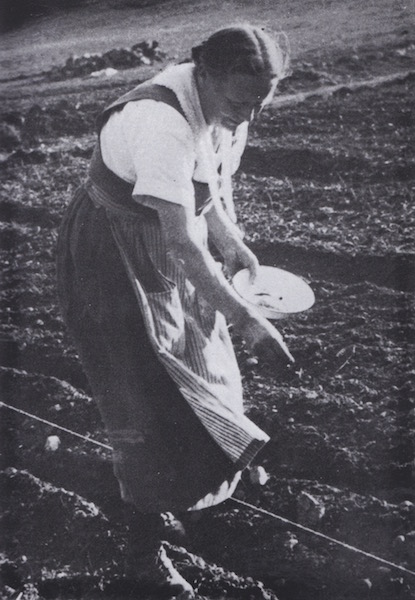
Mina Hofstetter had a fascinating life story being left alone to feed her four children, since her husband died in WWI and thereby found out how to do it most efficiently through taking care of the earth according to age old traditions.
In this netbook you can read an article bout Wägner´s and her friend and neighbour Flory Gate´s interest in Mina Hofstetter´s ecological farming, as the first one to to start ecological farming 1920 in Switzerland
Peace with the Earth Women and the Swedish Environment
With Abby Peterson
Carolyn Merchant writes this in her book Earth care Women and The Environment About Wägner o Mina Hofstetter
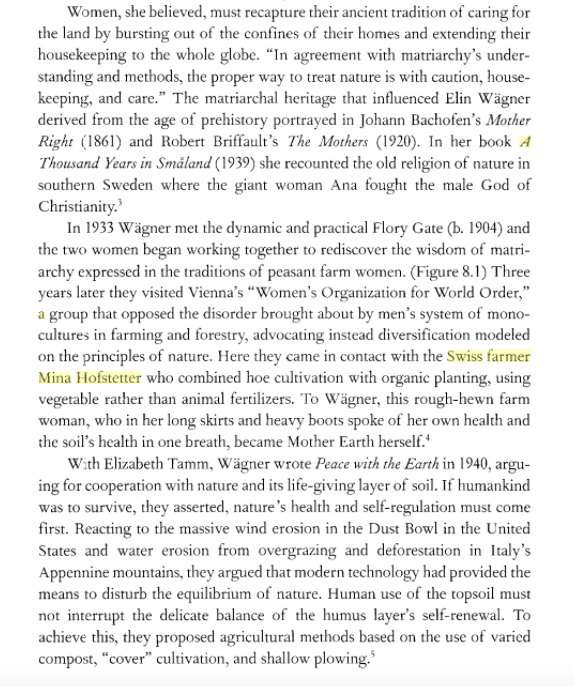
W O W O : s P R O G R A M M E
≈
"The period following the first War was a time of declarations and international treaties. The programme of the WOWO, and their ambitious declaration, should be read as radical, but in their time and context fully reasonable forums for expressing political alternative. In the material concerning WOWO three document are of interest here:
Firstly they formulate a two-page programme stating their platform (scroll down to read the transition posted here)
Secondly they conducted a survey addressing women´s status in society and the family that had 40 questioning its Swedish version, and 66 in its German original.
Thirdly they drafted a 10-page declaration for a new word-order (posted here below)
The WOWO´s programme starts by observing that patriarchy has failed. Male dominance has found no means of solving social and economic problems other than violence and war, and since violence is always the sign of bankruptcy of reason, the women of the WOWO refuse to follow such leader. The time is therefore ripe for a fundamentally new political orientation where the furtherance of humankind through economic and political means is transformed from utopian vision to action.
The women of WOWO also demand a half share of the power, that money put into weapon of destruction should be redirected into construction projects, and that everybody should be guaranteed a sufficient level of subsistence for the duration of their lives. The programme ends with the exclamation:"
W O M E N O F T H E W O R L D, O P P O S E T H E W A R
A N D C R E A T E T O G E T H E R
A N e w W o r d - O r d e r
≈
Mathilde Vaerting 1884-1977
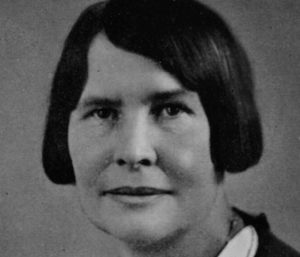
The members of WOWO were many of them encoureged by the the idea of a former prehistoric matriarchy, primarily investigated by Bachofen, to start a new word-order created by themselves, a project that strongly appealed to Wägner, who had been investigating the topic, ever since her first encounter with the Austrian professor and educationalist Mathilde Vaerting´s (1884-1977 ) feminist work; Neubegrundung der Psychologie von Mann und Weib, 1921 in the beginning of the 1920´s (in which matriarchy and patriarchy is seen as mirror images of one another, the only difference being the sex of the ruler) the idea of an earlier prehistoric matriarchal past became one of the cornerstones in her theorising, even if she never accepted Vaertings idea as a whole, but had some reservations towards it´s oversimplifying worldview and lack of evidence. I don´t think that Wägner´s view on human nature was that crass that she imagined relationships as inevitably entangled into a power related fight for domination; her worldview was far too much idealistic for that. And besides - I don´t see why there shouldn´t be as "natural" to seek for balanced relationships of the simple reason that you don´t feel comfortable by dominating or being dominated.
As Wägner´s references to the topic of prehistoric matriarchy from now on were expanded by new studies and investigtions, she obtained an increasingly distinguished and adequate concept of what it might be to live in a matriarchal society in comparison with the prevailing patriarchy, its outline and inner structure credibly and inspiring portrayed in her light and witty style in Väckarklocka, (Alarm Clock)1941. And I suppose that eventually made her more crititical against the lack of evidence in Vaertings theorizing.
The second encounter with the subject was offered by her second male partner after her divorce from Landquist; the author Sigfrid Siewertz, who had written a travelogue from his visiting a matriarchy on Sumatra about which Elin Wägner writes three long articles in Tidervarvet, in which she notes, that the author stating it as a peculiarity, that this matriarchy on Sumatra (the greatest matriarchy in the world with about 5 miljons of inhabitants; Minangkabau, which has been thoroughly investigated in late 20th century by the anthropologist Peggy Reeves Sanday) seemed to be compatible with a relatively high cultural level, thereby revealing that he shared the common opinion, that matriarchy only can exist under primitive conditions, and be prevalent among such lower forms of societies in which there are no monogamous marriages to ensure the patriarchal lineage.
Elin Wägner objected to this view, and argued instead for the one of Mathilde Vaerting in her articles, although partially critical to it herself.
Bertha Eckstein Diener 1874-1948

Not until the worldfamous author and Nobel prize winner Selma Lagerlöf once in the beginning of the 30s happened to tell Wägner that she had received such a weird book from an Austrian writer called Mütter und Amazonen and offered Elin to borrow it, she got really hooked on the subject of matriarchy.
Mütter und Amazonen, Ein Umriss weiblicher Reiche (München 1931) by the pseudonym sir Galahad, that Bertha Eckstein Diener had chosen to hide herself behind, is no original scientifical work but sooner some kind of light fluently essay presentation mainly built on JJ Bachofen´s (1815-1887) classical work: Das Mutterrecht; Eine Untersuchung über die Gynaikokratie der alten Welt nach ihrer religiösen und rechtligen Natur.(1861) and Robert Briffault´s giant work in three bindings: The Mothers. A Study of the origin of sentiments and institutions (1927)
"In the beginning was the woman" is the fundamental thesis in this utterly comprehensive work, drawing on a wide range of mythological, ethnographical and sociological material. That this book was to exert a deep and and quite a decisive impact on Elin Wägner, appear from her own comments in her letters and Work book from now on.
"Bertha Eckstein Diener starts with the bold statement: "This is the first feminine history of culture". History has too long been interest only in men´s doings, she declares, now it is time for women. The great discoverers of matriarchy Bachofen and Briffault she continues: `What we received through Bachofen was inconceivably good, not a museum piece, not a palace we can stride through, rather the ride and fall of the great breath itself.´ The appreciation she shows Bachofen and Briffult is not extended to Vaerting. Eckstein Diener comment on Vaerting´s theory of history, the idea of a shift from father right back to moher-right, and finds it ungrounded. (claiming he opposite, from matriarchy to patriarchy is not a problem) But she does finds Vaerting to be both stimulating and entertaining.
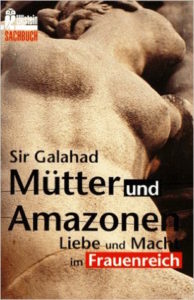
Elin Wägner would use very similar wording in describing Eckstein Diener many years later. In an autobiographical letter from 1948 she writes: "The first time I thought it was one of the funniest and craziest book I had ever read, but after the third or fourth time I started to realise that nothing is too fantastic in women´s history."
Wägner however didn´t either find Vaertings ideas much to trust, as she writes:
"She assumes that men and women are exactly the same and change as they ruling or ruled over. I don´t think one can build a whole way of thinking on that theory" (...) I was fascinated by her but i could not stop at her standpoint".
Sofie Lazarsfeld 1881-1976
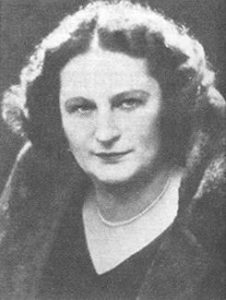
"Sofie Lazarsfeld (1881-1976) was a psycho analyst who had received her education from Alfred Adler. She published articles on sexuality in the Viennese Arbeiterzeitung and published several books on individual psychology between 1920- 1960. Her book Wie die Frau den Mann erlebt: fremde Bekanntnisse und eigene Beobachtungen (1931) is a handbook on psychology of sexual difference and were translated into Swedish and English. Lazarsfeld was involved in the social democratic movement and her work has been characterised as the "Austro-marxist programme for sexual pedagogy, directed at women".
She views the hierarchical power relation between the sexes as a central cause of problems in the relationshiops between women and men. Bachofen and Vaerting are immediate references, and she writes that Bachofen´s theories have been scientifically confirmed. Lazarsfeld´s analyses of the problems of modern relationships build on Vaerting´s theory of power and she declares that characteristics are based on the power relations of between the sexes.
Wägner and Lazarsfeld formed a close friendship (and Wägner even attanded psychoanalytic sessions by her in Wien, my comment.)
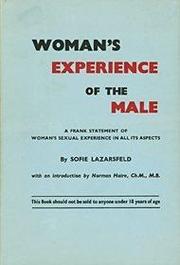
Lazarsfeld gave a series of lecturers in Sweden in 1936 under the title: The Neuroses of Pariarchy."
According to what is mentioned about her on Wikipedia; her own son accuses her of having destroyed three men, his father and the brother to the psychoanalyst Adler; Friedrich Adler who assassinated a minister in Wien, and himself.
Fannina Halle 1881-1963

In the second chapter of Väckarklocka with the heading View from Parthenon, Elin Wägner lists some of the female writers, as for example Mathilde Vaerting, Bert
ha Eckstein Diener, Ida Lublinsky who had got Bachofen and Briffault to thank for having been put on the vestiges of women´s forgotten history, whereof Fannina Halle is the last one. She was a personal friend of Stalin and had written a book about women in Sovjet: Frauen in Osten and lectured about that in WOWO.
Quoting Wägner:
(My own translation)
"In this book, you can get a glimpse of what could be delineated as a new pole change (referring to the pole change from mariarchy to patriarchy from Bachofen´s vocabulary) In the Asian Sovjet republics Lenins order that women should be treated as equals hit like a bomb. The effect was greatest where the women had been most deeply despised and oppressed. An "ukas", a proclamation on a marketplace, and the women blow up like burning flames. They toore off their veils, learnt in flying haste to read, to write, to lecture and to pursue their authority as the president of the village sovjet. There is nothing more touching and more unknown sensation than that one which took place here within human beings, which had been treated far more worse than animals.
The news about the female dignity probably was striking more sensitive minds than we can anticipate in Europe, where everybody now is dragged through the military and industrial screw. And what more is; no general order will give as influence on the fate of the world. But the more important it is, that we find inspiration from the lessons from history.
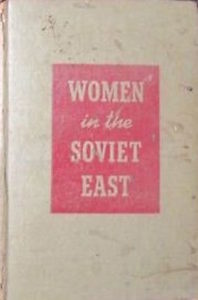
My aim with the following is not to replace the study of the work mentioned above but to encourage to that. It is remarkable that most of the mentioned authoresses worked in Wien, where there before 1938 was a circle of studying women who listen to them. Similar groups are now only to be thought of in democratic countries, but there is yet again the the difficulties that the women all too much fear to be considered fanatic and dotty. But I then think that someone have to assume the task to be fanatic and dotty, since they are needed for to prepare the ground for the creative people to forcefully through in the vision of the mother - age in the angst-ridden time of permanent catastrophes that we live in.
The material is far away from complete yet. But we will have to take the risk and draw our conclusions although. We cannot sit pasted on to the old history writing, it is much too dangerous if we so do."
When you consider that many of these brilliant women, who wrote books and /or lectured about gender issues and / or women history at the WOWO - congresses were in the underprivileged position of having been excluded from formal education on a higher academic level, when they were young, you must really admirer them for their insistent determination and self-confidence to pursue their own issues, in the complete opposite direction of their contemporary male stream society, not only in the view of themselves as no less competent decision-makers than men, quite the contrary so, which Elin Wägner succesfully pointed out in their first declaration of human rights, by generously stressing that men were equal to women, but also considering their own judgement abilities regarding philosophical and scientifically matters; not at least the ones dealing with their own so called “nature” and about women history.
You must also admirer them for being so wise and far ahead of their time, as to stick to ideas that some of them appear modern even today, as for example the proposition of a citizen´s income, as well as to hold on to their internationalism and advocation for peace, when the male stream moved backwards towards nationalism and yet another war.
To understand their contestable readiness to combat the patriarchy at any prize, you must perhaps consider the cultural and political atmosphere in the “Fin - de - Siegle” - Vienna, a centre of culture & science, which began too loose its former influence as the leading metropole in Europe by the turn of the century and the collapse of the former Habsburger regime, to which the so called "feminisation" of the society was to blame, as well as Eve the Scapegoat (the "men-women") and and the "others" in this case the jews - often looked upon as of one and the same kind of threat to civilisation..
Probably it is no coincidence that there were quite a few female scholars and self-taught intellectual women precisely in Vienna in the beginning of the last century who engaged themselves in the more or less philosophical or social / anthropologal issues of culture / sex and civilisation, as it had been hot stuff since long right here, not at least due to the much beloved ideas by Otto Weininger, the greatest misogynist ever, describing the female element as a threat against civilisation; this kind of higher more spiritually elevated apolonian order managed by men only.(I noticed recently that a Nazi-group here in Sweden had taken up his ideas publishing an article about them on their homepage)
The time before WWI - the so called Fin-de-Siecle -period, thoroughly portrayed by the brilliant scholar Carl Schorske in this book, as well as between WWI and WWII there seemed to have been a constant political turmoil of a very special kind in Vienna.
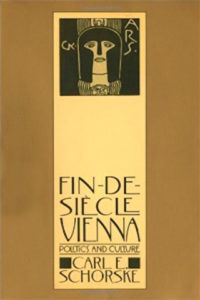
In the 1860s classical liberal politics came to the Habsburg empire and to Vienna, long after it had emerged and waxed in France, the United States and England, but this period of liberalism was quite short lived, being effectively dead by 1900. The collapse of liberalism and rise of right wing, conservative and anti-Semitic forces left the small liberal community of Vienna reeling in shock and dislocation.
The empire itself continued to decline and shortly ceased to even exist as a formal legal body. But the legacy of this golden period of Viennese culture holds a high place in Austrian history. Carl Schorske not only documents and details the story of the rise to glory of this Viennese version of modernism, but creates an historical photo of a period which strongly suggests the coming horrors of the period which follows just a few short years after this period comes to an end. His book is perhaps THE authoritative source on this period of Viennese history, and is unquestionably so in the English language.
In this vacuum there seemed to be a strong tendency of the remnant upper class and intellectual class of liberals which is described as being "of despair of politics, turned toward aesthetic romanticism, the occult and the rejection of the values and meanings of the past. In so doing they created a phenomenal milieu of high culture and models of a new society which would blend with the rise of modernism in other parts of Europe."
Look at these paintures by the famous painter Gustav Klimt and then judge for yourself what kind of view on the human "nature", and especially so the female one, that this discourse of modernism represented - not hard to guess from where it originated, namely Freud and Jung, but also from Bachofen´s revolutionary interpretations of Greek mythology, which eventually came to exert a great impact on many following scholars, although most of the late 20th scholar don´t agree on his interpretations of its revealing a prehistoric gynocraci. Anyhow you recognise in his art many of the mythological and symbolic female representations that most probably have matriarchal roots, as Heide Göttner Abendroth convincingly has shown in her The Goddess and her Heros.
T H E V I E N N A S E C E S S I O N - K L I M T, F R E U D A N D J U N G
Philosophie (2007)
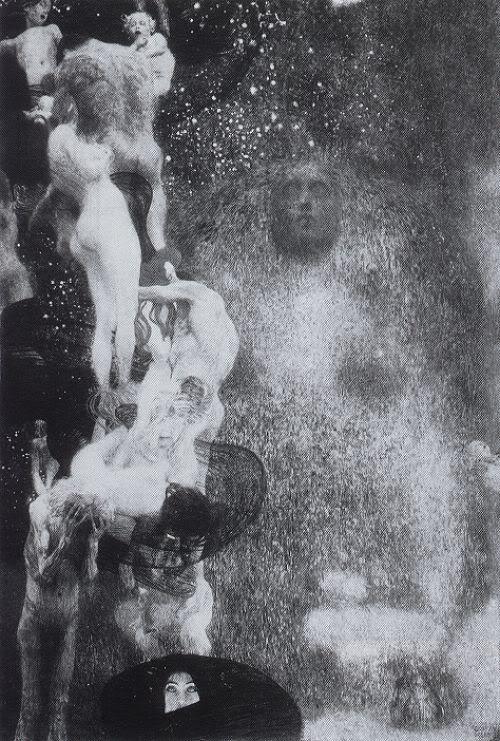
The issue of nature/culture/civilisation is a tricky one to tackle in a condensed format as this, as the vocabulary is used differently in English and German and sometimes even is interpreted as representations of three evolutionary steps following each other sequently, but that was for sure not what was done by the feminist in this Austrian context, who instead directed their critic against what in German language is thought of as "civilisation" and pursued a more modern updated system-oriented view on the question of nature and culture than what their male stream opponents did by that time (as opposite to now?). The delineating of art and literature from the same context as "modernism", is also confusing as it to me sooner seems obsessed with the same old issues of shame and guilt and sexual neuroses as “always” in the Old Testament Christian context, with women portrayed by Gustav Klimt as queer witches or sexual monsters devouring poor old ugly and skinny men, and life as a frightening flew of dead bodies floating around in an empty space. I cannot see anything "modern" in that, nor how and why this kind of representation of "reality" would inherit the potential to combat the positivist discourse in science, which among others is proposed in this article: Vienna secession - Klimt, Freud and Jung.
Gustav Klimt 1862-1918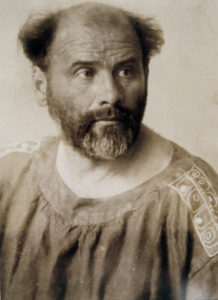
I can see no reason at all why reality always must consist of empty horror, violence and oppression, as I by own experience know of reality often being pleasant and enjoyable and I don´t think that violence is entertaining - as for example the romans did, who were even worse than ISIS; as they made it to a first class entertainment to watch a young mother alive being torn into peaces by a lion as a punishment for being a christian.
And NO - I do not think that we all of us are sado-masochist in the depth of our souls. I don´t think we are anything static fixated at all but plastic adaptive to our socio-cultural surroundings and that the quality of the relations we let ourself into is deeply dependant on the quality of our upbringing in childhood, and that we all of us are entangled in a web of interrelatedness that we are products of at the same time as we create by our contributions to it of emotions, ideas and actions.
This is so obvious that its embarrassing having to state. Nonetheless it has turned out to be far too a complicated issue for male stream science to tackle, which seemingly only is adjusted to deal with tasks of differentiation and the detail but not integration and the hole and least of all feedbackrelated dynamic organic systems in constant change.
Medicine (2007)
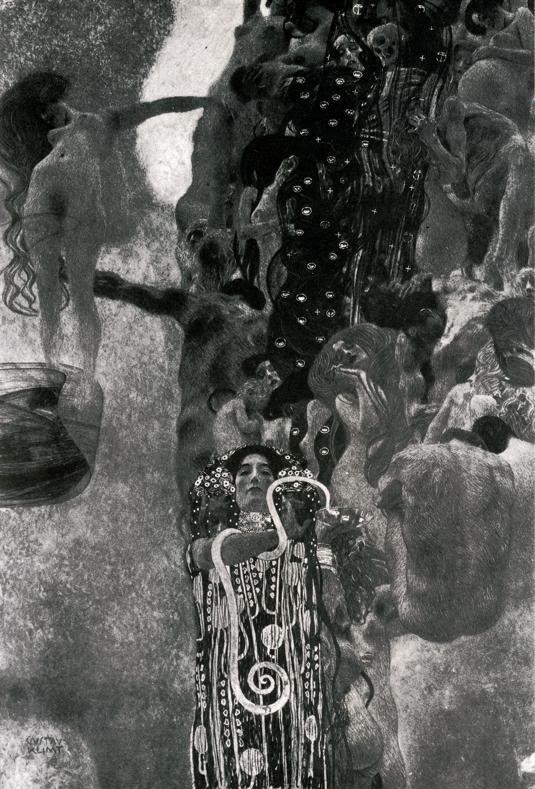
No doubt that Klimt was a really brilliant and fascinating painter, but one would gladly like to know what was in his mind, as well as in that of the Ministry of Education when he and his business partner Franz Matsch was comissioned to paint what came to be known as The Faculty Paintings, which were to be placed on the ceiling in the Ministry’s great hall.
As the outcome of the three painting that Klimt was assigned, Philosophy, Medicine, and Jurisprudence, which were expected to be celebrations of the achievement of rationality in the modern world, there were instead these heavily Freudian symbolic and spooky paintings with idle naked women and skinny poor men in sceneries as from a nightmare. Not at all representing the light conquering the dark in the name of enlightment, human rationality and progress, merely quite the contrary so - the human beings struggling against their dark “nature” whatsoever.
And no doubt that all the great male genius of the time as for example Nietsche, Schopenhauer, Richard von Krafft-Ebing, Wittgenstein, Weininger, Freud et. al possessed incomparable abilities to figure out complicated things about what to do after they have killed their own Father God and the great alienation people was afflicted with thereby, their huge problems with their Oedipus-complexes from the irresistible need to sleep with their mothers, as well as to have unlimited access to sex, and that it was crucial for the survival of the arian race that we women got enlightened by their genius scientifical findings about their female nature as for example their inate penis - envy and natural favour of submit to the rule of the testicles, as well as about how to raise children.
Why shouldn´t they, as they were the only ones who enjoyed access to higher academic studies?
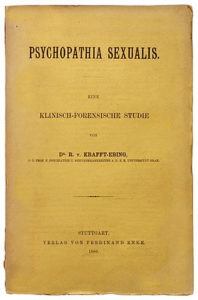
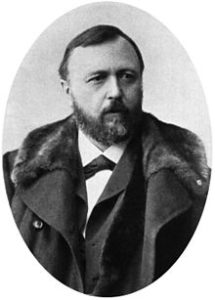
Anyway Klimt had to remove his paintings and later on they were destroyed by he Nazis.
Much fuss thus and little ado, so to speak.
Jurisprudence (1907)
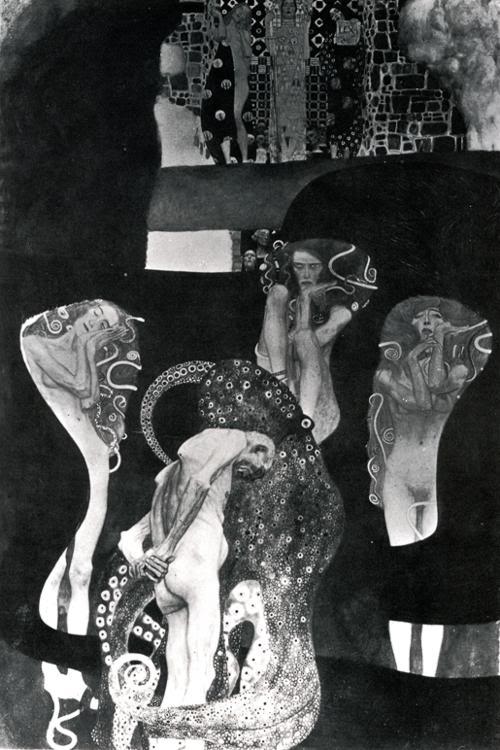
Was this maybe the origination of the Nazi´s disgust of “Entartete Kunst”?
"Last night, I started reading a book I purchased from a 2nd hand store about Gustav Klimt written by Gilles Neret. I happen to admire more than a few of Klimt’s paintings. Most people do. But, do most people know what is behind these paintings? The radical left knows what lies beneath the obvious. The Liberals are the ones who made Klimt’s art popular again in the late 60’s, early 1970’s. A Christian or a Conservative does not usually look into the root of an issue. Why? Because most Conservative or Christian people do not seek out the worst. They usually always believe the best. A Conservative person sees a piece of unusual art that is pretty, loves it – buys it.
Some facts about Klimt and other artists that entered the art scene in Vienna, Austria, circa 1905: Many of their paintings depicted grotesque naked people. The artists called this movement the “Secession”. These artists painted eroticism. They wanted to ‘break free of the chains of censorship’ & this is why these certain artists painted vulgar nudes. Artists were not ‘censored’. On the contrary, there is a flow to sane culture. Polite society never realized that some devils were in the details of these ‘revolutionary’ artists. The reason they painted such disgusting nudes was to enter a ‘brave new world’ of left-wing insanity and to thwart the natural flow of life.
The left has always been among us since the dawn of time. The left was the snake in the Garden of Eden. The left began to destroy society in Europe starting at the turn of the 20th century and Gustav Klimt is proof. Klimt’s own admission of railing against sane, Victorian culture and conservatism"
Otto Weininger (1880-1903)
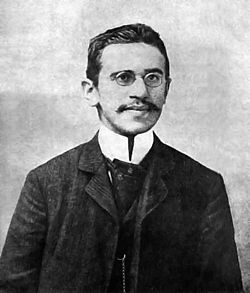
This so called "modernism" was in fact percolated by the most fervid misogyni, that in Leppänens as well as in most other male stream scholars works is explained as the result of women´s fight for equal rights, but which I rather would suggest simply is the innevitable product of patriarchy itself, women´s fighting back or not.
The most passionate misogynist beyond comparison was the young scholar Otto Weininger, who like the contemporary ISIS-fighters of today wasted his life away by committing suicide (in the same house as Beethoven had died in Vienna), in order to appear as a real hero, which latter inspired many young men to do the same. And so did also many young girls out of sheer dispair of being women and / or deadly hurt by the derogatory adressings of their male schoolmates about their inate lower human qualification due to their "female nature". (Elin Wägner knew too young Swedish women: Elsa Beckius who shot herself after a love affair with a university mate in Uppsala and his derogatory dissmissal of her, and her own sister in law Ellen Landquist who slowly faded away in illness of similar reasons.)
In Encyclopedia Britannica (in which there isn´t one single word mentioned about Marija Gimbutas or Robert Briffult) you´ll find these lines about him:
"Otto Weininger, (born April 3, 1880, Vienna—died Oct. 4, 1903, Vienna), Austrian philosopher whose single work, Geschlecht und Charakter (1903; Sex and Character), served as a sourcebook for anti-Semitic propagandists.
The son of a prosperous Jewish artisan, Weininger became a Christian the day he received his Ph.D. degree from the University of Vienna (1902). The following year he published his partly scientific, partly philosophical study in which he advanced the thesis that all living things combined varying proportions of masculine and feminine elements. The masculine element was positive, productive, and moral, while the feminine was negative, unproductive, and amoral."
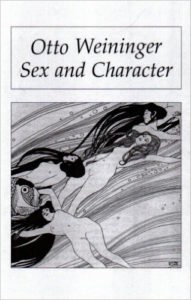
Thus, in order to get a background to the boldness of the WOWO- these women´s initiative was, or perhaps better; the wrath that prompted them to act - you would have to take a closer look at least one of the crucial reasons for that, which most probably have been the misogynist gospel: Geschlecht und Charakter (Sex and Character) by Otto Weininger that had been authorised as "science" by the Sanctuary of Male Stream academics by that time, and built upon the same ides of the physician Paul Julius Moebius about the female hysteri, that even Freud himself took over.
It is even said that the latter plagiated Weininger in his writings about the female kind of libido, simply omitting all he rubbish about the "jewish" which was likened with the passive and "female" and cowardliness.
Anyhow, after months of concentrated work, his book Sex and Character – A Fundamental Investigation – an attempt "to place sex relations in a new and decisive light", was published in Vienna containing his thesis to which three vital chapters were added: (XII) The Nature of Woman and her Relation to the Universe, (XIII) Judaism, (XIV) Women and Humanity”.
Weininger´s cult of the genius and manliness was soon too become incredible popular among the most famous philosophers and authors of the first half of the 20th century as for example Ludwig Wittgenstein, August Strindberg, Gottfried Benn, Ernst Jünger, Carl Schmitt, Robert Musil, Julius Evola, Georg Trakl, E.M. Cioran, Karl Kraus, Alfred Kubin och Franz Kafka.
Sex and Character argues that all people are composed of a mixture of male and the female substance, and attempts to support his view scientifically. The male aspect is active, productive, conscious and moral/logical, while the female aspect is passive, unproductive, unconscious and amoral/alogical. Weininger argues that emancipation is only possible for the "masculine woman", e.g. some lesbians, and that the female life is consumed with the sexual function: both with the act, as a prostitute, and the product, as a mother. Woman is a "matchmaker". By contrast, the duty of the male, or the masculine aspect of personality, is to strive to become a genius, and to forgo sexuality for an abstract love of the absolute, God, which he finds within himself.
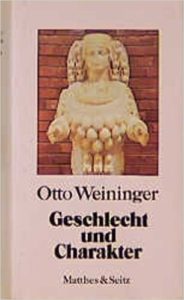
In a separate chapter, Weininger, himself a Jew who had converted to Christianity in 1902, analyzes the archetypal Jew as feminine, and thus profoundly irreligious, without true individuality (soul), and without a sense of good and evil. Christianity is described as "the highest expression of the highest faith", while Judaism is called "the extreme of cowardliness". Weininger decries the decay of modern times, and attributes much of it to feminine (or identically, "Jewish") influences. By Weininger's reckoning everyone shows some femininity, and what he calls "Jewishness".
Its really remarkable that there still hasn´t been the tenth of attention payed to the fact that established male stream so called "science" have been used in this way to belittle and demonise women in the most stupid and nonscientifical way - in comparison with the enormously timewasting amounts of strain; decades or even centuries full of totally meaningless endeavour, spent by wellpayed academics in order to convince the world of its being an erroneous idea, that women once might have been in the lead of the cultural evolution of balanced and relatively peaceful societies (and still is, in some places around the world), as well as the immense time they have wasted on the exhaustive enterprise to bury its pursuer under tons and tons of bollocks and far-fetched lies.
What if it´s wrong, and there never has been any women in the lead of the evolution of societies in balance and peace - what harm would it do if they believe so and therefore get the confidence to work for it - in comparison with all the young women from the beginning of the 20th century and forward committing suicide because of being deadly hurt by not being allowed to commit higher eduction because of their supposed loss of spiritual and intellectual capacities therefore, as well as the condemnation by their lovers, seducing them, just to leave them for having been too weak giving in.
Paul Julius Möbius (1857 - 1907)
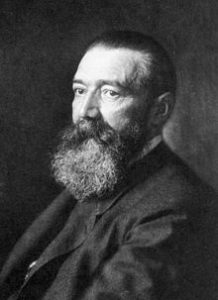
The ironically with the subsequence in this young man´s fate, only 23 years old by then, is that he totally lost his mind from the fact that he was attacked by Paul Julius Möbius, professor in Leipzig and author of the book On the Physiological Deficiency of Women, being accused of having plagiarized him!!! OBS!
Deeply disappointed and seemingly depressed, Weininger then took a room in the house in Schwarzspanierstraße 15 where Ludwig van Beethoven died and committed suicide there, the man he considered one of the greatest geniuses of all, made him a cause célèbre, inspired several imitation suicides, and created a lot more interest in his book. The book received glowing reviews by August Strindberg, as well as by many others of he most outstanding scholars and intellectuals of his time as for example Ludwig Wittgenstein, Frans Kafka, Cioran who wrote that it had "probably solved the hardest of all problems", the "woman problem".
Paul Julius Möbius (1853 1907) was a German neurologist born in Leipzig. He was a prolific writer and is well known for publications in the fields of neurophysiology and endocrinology. Among his writings in psychiatry were psychopathological studies of Goethe, Rousseau, Schopenhauer and Nietzsche.
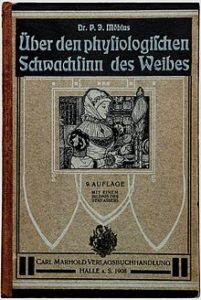
Möbius made pioneer contributions towards the understanding of how some mental illnesses occur. He is credited for providing a distinction between exogenous and endogenous nerve disorders, and introduced ideas on the etiology of hysteri.
Today his most historically significant contribution to science is his work on the psychogenics of psychiatric and mental illnesses, such as hysteria. For the first time in the German-speaking world he postulated psychological causes of disease. For this reason and because of his convincing arguments for the therapeutical effects of electrotherapy, Sigmund Freud referred to Möbius as one of the fathers of psychotherapy.
F R E U D ´S S E X U A L P S Y C H O L O G Y
Sigmund Freud
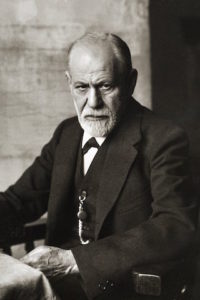
As I have found this chapter about Freud far to tricky to tackle on my own under this constraint conditions, all of this text about Freud is quoted from Leppänen, apart from the one containing Wägners letter about her interview with Freud.
"Wägner and Mayreder were both familiar with pychoanalysis and had met Freud personally. Wägner visited him in Viena 1920 to do an interview but found him to be to misanthropic for her liking"
Wägner is writing in a letter: (My translation) “Send my greetings to dr X and tell him that I was visiting professor Freud yesterday He was very friendly and considered my questions interesting and rather whitty. But I didn´t get that much interesting answers. Thus my questions might not have been as whitty as they should".
"She later comments in a letter to Emilia Fogelklou, on reading the Swedish psychoanalyst Henrik Törngren, that he founds psychoanalysis to be helpful for people in opening the connection between the conscious and the unconscious. To this Fogelklou replies "I think tht Feud in some ways really has been given his due and that one can safely move on."
"Rosa Mayreder consulted Freud together with her husband the architect Karl Mayreder, who suffered from mental illness in adult life, and Freud then traced Karl´s illness to feelings of inferiority towards his wife. It must have been a harsh diagnosis on the personal level for a couple who saw themselves and were seen by others as equal. But Freud´s diagnosis who really although also she had been excluded from higher education, was an outstanding talented and clever woman. But Freud´s diagnosis of the consequences of the reversed conjugal hierarchy is, of course quite on par with Rosa Mayreders analysis of how culturerepresents women, and reflects in her dairy:
" `I have written my obituary,´said Lino (Rosa Endearment for Karl) at breakfast. And after a pause he added:`It has the heading: Rosa Mayreder´s husband dead.´ At first I laughed but then I saw that it confirmed Freud´s view that he suffers from my personality because it suppresses his masculine prerogative (the need of men to feel superior to women) ...If I had to admit that it would be the ultimae martyrdom for me, the complete loss of everything which made our life together valuable."
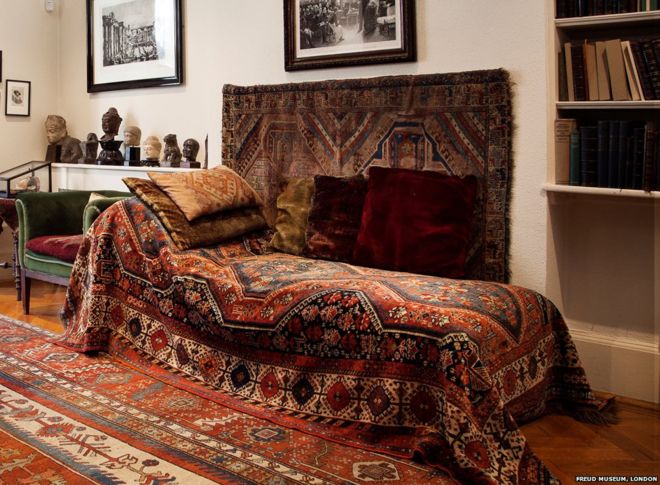
Wägner never tried this famous couch
"Freud declared in 1930 the the psychological problems of this time were the result of a conflict between human nature and civilisation (Civilisation and its Discontents) This diagnosis was not new but had in fact ben circulating for some time. Many feminists accepted it although with some different remedy than the one Freud offered. The emergence of sexology or sexual psychology in the late 20th and early 21st century has been the interest of several feminist studies as the arguments of sexual difference were both in scientifically and politically in turmoil.
Richard Kraft Ebbing, Sigmund Freud, Otto Meininger, Havelock Ellis and others on the one side and numerous feminists on the other Grete Meisel-Hess, Rosa Mayreder, Sofie Lazarsfed, all analysed the meaning of sexuality in relation to the social order.
"While some viewed the feminisation of culture (and of men) as a threat to culture itself, others argued that more feminisation was needed in order to rescue culture from negative sides of modern society. The centrality of sexuality as an object of social interest i closely connected with a non-individuals understanding of sexually at the turn of the century. Sexuality was linked with ideas of race, nation, generation, health, upbringing, work, militarism and the power between the sexes. Changes in sexual relations could therefore potentially affect almost every aspect of life which is why sexual psychology, the study of the relationship between individual sexuality and social reform, was of the utmost importance for the collective. It was also in the act of sexual intercourse the men and women, male and female, met by necessity. Kraft Ebbing for example was convinced that it was important to uphold the dominance of man in the sexual act in order to keep the social power relation intact."
"Viewing the feminist movement as a transgression of female sexuality is a recurrent interpretation at the turn of the century. Otto Weininger comments the feminist movements ambition to transgress female sexuality as the turn of the century and declare therefore feminists to be Mann-weiber ( men-woman) while Sigmund Freud believes that the psychosexual development of feminist had been arrested at a stage predating the overcome of penis envy. This pathologising of individual feminist women reduces the social dimensions of the movement - calls for emancipation are viewed as symptoms rather than politics. Harriet Anderson has shown how anti-feminism based on repressive sexual morality is a widely accepted political phenomenon in Viennese public debate. Accordingly, feminist are not only ill but also immoral."
"Mathilde Vaerting cuts to the quick in her analysis of such an attitude. The oppressor creates and enhance differences between themselves as a group and those they oppress, in order to legitimate privileges that others would seem unjust. Differences is thus paramounts in all oppression. The aim of this type of falsification of historical and psychological scientific results is to destroy women´s selfconfidence and thereby keep their subordination intact, Vaerting argues."
"Both are however expressions of the same misogyny that strikes women who enter the public sphere. The core of the knowledge wars, the continuos necessity of women to counter allegations against their intellectual and political suitability, is a battle in which the women of this study take part."
G E S C H L E C H T U N D K U L T U R ( Gender and culture )
W H A T I S A W O M A N - N A T U R E O R C U L T U R E?
"What is woman, or rather what should she be, as Mayreder poses the question in the introductions to the two volumes of culture, sex and womanhood There is no easy answer to the question in either Wägner´s or Mayreder´s books. Perhaps the question itself i wrong? Still they booth elaborate extensively on the problem of finding a simple definition of the woman or the feminine.
Rosa Mayreder 1858-1938
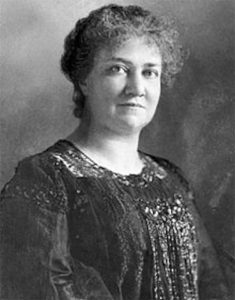
Agatha Schwartz on Mayreder, 'Gender and Culture'
An Early Austrian Feminist Classic: Rosa Mayreder’s Gender and Culture
"Rosa Mayreder’s collection of essays Geschlecht und Kultur (Gender and Culture) was published in 1923 by Eugen Diederichs in Jena, Germany. It was a sequel to her collection of essays Zur Kritik der Weiblichkeit published nearly two decades earlier, in 1905. Yet unlike Zur Kritik der Weiblichkeit, which, soon after its publication in German, was translated into English as A Survey of the Woman Problem (published by Hyperion Press in 1913), Geschlecht und Kultur has remained unknown to a wider English-speaking readership until recently. In 2009, Ariadne Press brought out Pamela S. Saur’s translation of this important feminist work from Austria.
Mayreder was one of the pioneers of Austrian feminism. Born Rosa Obermayer in 1858 in Vienna, she became a brilliant, though mostly self-taught, writer, poet, social critic, cofounder of the General Austrian Women’s Association (Allgemeiner Österreichischer Frauenverein) and its vice president in 1894, and, for a period, coeditor of the association’s journal, Dokumente der Frauen (Women’s documents). In addition to fiction and an autobiography (published only posthumously in 1948), she published numerous important essays on gender relations, the cultural construction of gender, marriage, love, and sexuality. She was a heavy critic of the sexual double standard and of prostitution, which she considered one of its consequences.
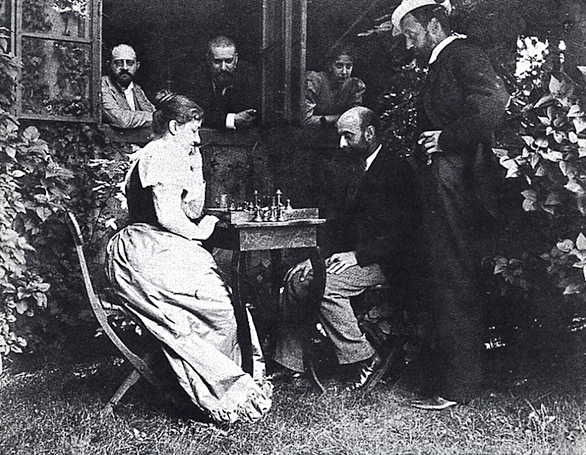
Rosa Mayreder playing schess with some men
On her seventieth birthday, in 1928, Mayreder was made honorary citizen of Vienna in recognition of her accomplishments. She died in her native city in 1938, shortly before the Nazi takeover. Her life and work fell into oblivion for several decades after that, only to celebrate a comeback since the mid-1980s. Besides the scholarly attention given to her life and work, a fair number of her texts have been reedited in German (including Der letzte Gott [The last God], in 2008 by Tatjana Popovic; and a Mayreder reader under the title Zivilisation und Geschlecht [Civilization and gender] in 2010, edited by Eva Geber von Mandelbaum). Her diaries were brought out for the first time in 1988 by Harriet Anderson (Tagebücher 1873-1937). However, Gender and Culture is the only work by Mayreder to be published in English after her death. The importance of this translation cannot be stressed enough as it will introduce a wider readership to a major Austrian feminist and to her ideas which still resonate today.

As stated by Mayreder in the foreword, she had already written most chapters of Gender and Culture by the beginning of World War One and she had even chosen the title for this collection of essays. But the outbreak of the war and personal challenges (her husband’s depression of which not even Dr. Sigmund Freud was capable of curing him) prevented her from bringing this important book to completion and publishing it. The thoughts and concepts expressed in this book thus very much reflect the debates in which they were born and developed, namely, the Viennese fin de siècle. Mayreder offers the reader informed and carefully thought-out reflections on culture and civilization and the importance of gender in their construction, the moral double standard, the shattering of patriarchal concepts of masculinity and fatherhood, eroticism, marriage, and love. As Susanne Hochreiter points out in her afterword, Mayreder’s use of the term “woman’s nature” may sound problematic to our current understanding of gender construction. However, upon careful reading, it becomes clear that Mayreder’s position was not what one may classify as essentialist (that is, determined by human biology and therefore unchangeable). Quite the contrary, Mayreder defined “nature” as something determined by external circumstances and historical development and thus “capable of being changed as external forces change” (p. 27). With this position, she challenged the very strong misogynist discourse of her time, a discourse present in numerous contemporaneous authors among whom the most notorious was probably Otto Weininger. Indeed, Mayreder’s title alone reads as a challenge to Weininger’s extremely essentialist and woman-hating bestseller Geschlecht und Character (1903), a title rendered as Sex and Character in English but that should really be translated as Gender and Character. Mayreder took a position against Weininger in her earlier A Survey of the Woman Problem as well, a position she developed further in Gender and Culture to explain misogyny in Western culture as a historical phenomenon which she based on an abhorrence of the body and sexuality that had grown out of Christianity. Mayreder’s reflections carry relevance today given the resurgence of misogyny and its open and more disguised manifestations in many parts of the world.

Stilleben by Rosa Mayreder
Mayreder’s feminist position can be classified as cultural feminism. Her criticism of a patriarchal construction of civilization offers a reevaluation of women’s work and their contribution to the development of civilization and a rewriting of history from a feminist point of view with her statement that “civilization, in its technological aspect, would seem to be in its origins a feminine achievement because women everywhere were the first farmers, potters, weavers, tentmakers, in short, the first technicians” (p. 21). Moreover, Mayreder offered suggestions as to how to move beyond what was generally considered a fin-de-siècle crisis of culture. Only by repositioning the feminine and reevaluating women’s roles and participation in cultural work will a “harmony between culture and civilization” become possible (p. 27). Mayreder saw the establishment of gender equality as a necessary condition in that direction, an equality that would not deny some differences between women and men (such as their different roles in procreation) but that would allow women to participate equally in the public domain and, thus, bring about a woman-centered society in which women and men would be each other’s true and loving partners.
Mayreder’s idealistic and romantic views of gender relations were somewhat shattered following World War One and the crisis of her own marriage. Her foreword to the 1923 German edition expressed in part a cultural pessimism but she managed to end it on a hopeful and optimistic tone regarding future developments. Fortunately, she did not live to see her optimism completely destroyed by Nazi barbarism. Overall, her ideas in many ways foreshadowed future developments regarding women’s emancipation, the reevaluation of gender roles, motherhood and fatherhood, and the idea of partnership as a basis of marriage. They also remind us how much more needs to be done to achieve true gender equality."
